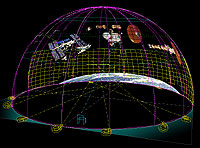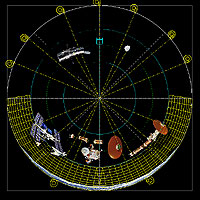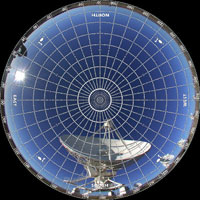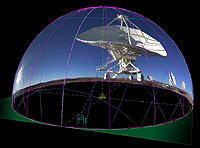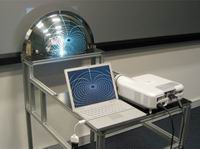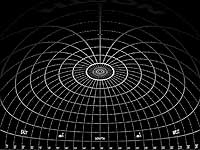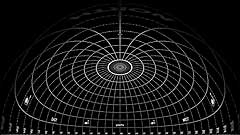...in which we answer many questions we receive about this medium
(often from those who work at classic, slide-based theaters)
Once upon a time, around the turn of the century, fulldome video projection was new. Few had experienced it, more were skeptical of it, and some were fearful of it.
Now, we've been using fulldome technology for more than a decade, and the previous millennium's film-based projector systems have been retired to the ashheap of history. It's simpler, more efficient and reliable, and getting better and better with each generation of hardware.
What do you mean, fulldome video?
Basically, fulldome video is the method of projecting a computer or video display onto the full surface of a planetarium dome. The images being projected are called dome masters, and they're cycled through at a rate of 30 frames per second (or thereabouts), creating an all-dome movie.
I've got a video projector in my theater now, for showing PowerPoints and stuff. You mean like that?
Not quite. The projector you're using just shines a rectangular image on the dome. We're talking about covering the entire dome with one honking big video image. No floating rectangles from single video projectors, just a huge video all-sky. This usually requires a video projector showing through a big expensive fisheye lens — or several.
Let's examine the presentation of a traditional multi-media planetarium show in a classic, slide projector-based theater. You'll have imagery appearing on an array of "screen areas" where banks of slide projectors are pointed. There will be a set of projectors with matched lenses trained on the horizon to make panoramas. Still more are fitted with wide-angle lenses to project all-skies. Some have motorized zoom lenses, trained on motorized mirrors to make images "fly" in and around the dome. Others areas have projectors stacked 2- and 3-deep to make lap-dissolve screens for crossfading animations. Each slide projector is only projecting onto a small area of the dome, though the planetarian usually goes through production gyrations to avoid showing obnoxious, unmasked slides and floating gray rectangles in space. There may be special effect projectors to create clouds and snow, ripples of water, flashes of lightning, rotating galaxies, and more. And, of course, you'll have stars overhead. And miles of cables running around to all the projectors, and dimmer boxes and switches and relays and computer automation and knobs and buttons and control panels... but we're getting ahead of ourselves.
Now if you (instead of the star projector) were standing at the center of the room and looking straight up, you would see the entire dome filling your peripheral vision. Snap a picture with your camera (assuming it had a wide enough lens to pick up the entire dome in its field of view), and it would look like this — a circle in a rectangle, with the zenith at the center, and the horizon around the circumference. That's a dome master.
If your camera could take video while the planetarium show was presented, you could record everything that went on in the theater, in that circle. Then, if you could play back that video you just took through a device that could project it over the whole dome... aha!
That's basically the concept of fulldome video: projecting a full dome's worth of imagery — circles called dome masters — through video projectors onto the dome.
A dome master is a "fisheye" image of a circle in a square or rectangular frame. The circle contains the image you want to project, curvature-corrected for proper display on the planetarium dome. This is often called polar projection, or more technically, an azimuthal equidistant projection. The center of the circle is the zenith point; the circumference is the horizon. 0° North is at the top, 180° South is at the bottom (the direction your audience is facing), east is left, west is right.
See Pineappleware's page for more illustrations and detailed explanations of dome masters.
In our example above, we mentioned aiming a video camera at the dome. That's not what we as show producers do, of course. We actually create the dome master circles for our shows using computer graphics software.
And while we say video projectors, we're really talking about computer graphics displays. The definition of video is not limited to what you see on television or rent from Netflix; they're called video cards in your computer, after all.
What's all this talk I hear about resolution?
A circle is a circle; a dome master is always going to be that shape. How many pixels are used to make the dome master image is what's significant for the purposes of this discussion. Put simply, how big is the circle? As in much of life, bigger is usually better. The higher the resolution (meaning, the more pixels you have to represent the scene), the sharper the image is likely to look. Bigger dome masters means more pixels to splash up on the dome.
However, we have to match our need and greed for pixels with the projector's ability to display them. Its display size is the limiting factor. It does you no good to have images bigger than the projector's display can handle. You end up throwing away pixels in order to scale down images to fit, and the resulting display looks blurrier as a result. A one-to-one image size to projection size ratio is the ideal. In other words, you don't want to be rescaling your images up or down; you want to show them at 100 percent size.
|
DISPLAY SIZE — DOME MASTER DIAMETER |
Select pic for actual size | AS USED IN THESE SYSTEMS |
Here are some dome master grids at various sizes commonly found in today's fisheye-lensed fulldome systems. Select each one to display it full size, starting with the smallest. Note — some browsers automatically try to downsize images to fit their windows. If you have yours set that way, be sure to choose the icon to expand the images, otherwise this will be an exercise in futility. With each increase in size, a greater number of pixels is used to create the image — in other words, the resolution increases. At some point, the dome master will be larger than your compuer's monitor can display. To be able to see more pixels all at once requires a bigger display. Fulldome projector systems use the same size of displays found in computer monitors and digital TVs. They're often modified models made by familiar manufacturers such as Epson, JVC and Sony. The bigger the display, the more pixels it can handle. So, you've got a dome master image that's a circle, and a rectangular display to show it with — the opposite of the square-peg-in-the-round-hole problem. Rather, it's just like fitting a planetarium dome in a square room; you don't care about the corners, since no one will see them (but unlike in a planetarium, you can't store junk on dusty shelves there). To fit the full circle in the frame, the diameter can't be bigger than the shorter dimension side, the height. Or can it? Some fulldome manufacturers have decided it's better to employ more of the pixels, rather than leave them lying unused on the sides. So they stuff as much of the circle as they can into the rectangle, until the diameter fills the width of the display. Now the circle is bigger than the display; there's an area that's cut off, or truncated. In a planetarium setting, this is not necessarily a bad thing. You can simply have the audience all facing to the front, and put the cutoff area in the back. Unidirectional seating is commonplace, audience members do not have eyes in the backs of their heads, and once they realize nothing is being projected in the back of the dome, they quit looking back there. Here's an illustration. Just as many computer users have dual monitors to increase their workspace size, some fulldome systems combine two smaller displays together to make one bigger array, blending the edges where they overlap. Each individual projector shows only part of the dome master, but together they can manage to display the Full Monty*. Just as with analog projector technology, there are tradeoffs; alignment and soft-edge blending issues come into play. Nothing is simple. |
|
1024 x 768 768 px |

|
Digitarium Alpha Digitalis Education Solutions |
|
|
1024 x 768 1024 px truncated |

|
definiti PD Sky-Skan OmniFocus X2 Elumenati |
|
|
1280 x 1024 1024 px |
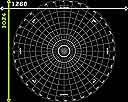
|
MEDIAGLOBE MEDIAGLOBE-II Konica Minolta |
|
|
1400 x 1050 1050 px |
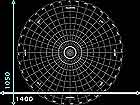
|
Digital STARLAB STARLAB Digitarium Gamma Digitalis Education Solutions SciDome HB Spitz, Inc. |
|
|
1400 x 1050 1400 px truncated |
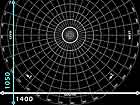
|
definiti ONE Sky-Skan OmniFocus SX6 Elumenati |
|
|
1920 x 1080(x2) 1920 px |
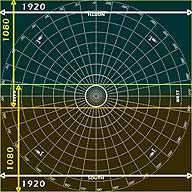
|
Digistar 4 SP2 HD Evans & Sutherland SciDome HD Spitz, Inc. |
|
|
2560 x 1600 1600 px |
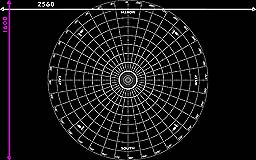
|
Digitarium Kappa Digitalis Education Solutions SciDome 1600 Spitz, Inc. |
|
|
2560 x 1600(x2) 2560 px |
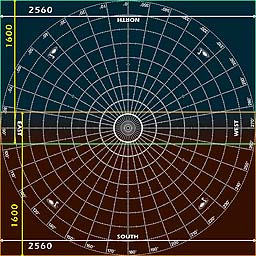
|
SciDome XD Spitz, Inc. |
|
1600 x 1200 3200 px |
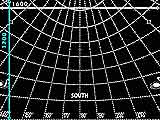
|
definiti Theater Sky-Skan Digistar 3 Evans & Sutherland |
The examples above posit that the center of the room is the location of the projector(s). But you could put your projectors around the periphery. The geometry of each projected rectangle will have a weird shape, especially the one pointing at the zenith. The dome master grid will be warped strangely too, as you can see. But that's what computers are for; they can adjust. The six-projector array is the most prevalent of these, especially for large domes. Each projector shows its own slice of the circle; in fact, the process of dividing the dome master into the movies that the individual video channels project is commonly called slicing. You would have a hard time slicing a pizza into wedges with these shapes. We've illustrated here a six-projector array using 1600x1200 projectors. The same geometry can be scaled up or down, using projectors with lesser or greater resolutions. |
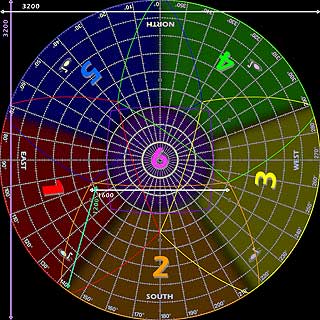
|
|||
|
4096 x 2160 4096 px |
definiti Theater Sky-Skan Digistar 4 SXRD Evans & Sutherland powerdome 4DOME Zeiss |
At the upper end of the scale, the Sony SXRD projector has been incorporated by several manufacturers. Its technology is a significant order of magnitude increase in resolution. Using just a pair of projectors on opposite sides of the dome, you can cover it completely with a "4K" resolution image. Woooo! But there's no stopping there. As of this writing, Sky-Skan has installed "8K" systems, using Sony SXRD projectors in a multi-channel array similar to the one above. Some have also "doubled-up" the systems to create stereo 3D theaters, wherein the audience wears 3D glasses, and a pair of projectors feeds each eye. |
|
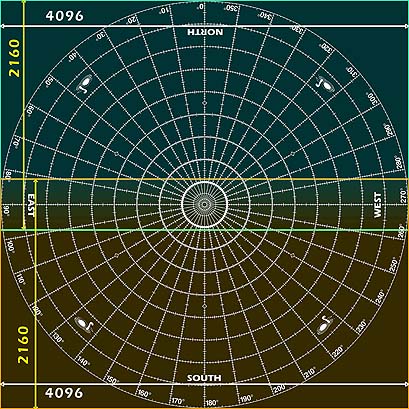
|
|||
| System names may be registered trademarks of their respective manufacturers. | |||
Wow, that's a lot of different projector systems already. Are there more?
Of course. For example, Zeiss has a system called SPACEGATE QUINTO which uses 5 projectors in the center of the theater. The Digistar 4 Laser from Evans & Sutherland can be configured with one or two laser projectors, either from the center or on opposite sides of the cove.
Our summary above is simply representative; many of those listed here come in different configurations with various options.
Wow, that's a lot of different sizes of videos to produce for, isn't it?
It certainly is. Of course, you as the planetarian only have to worry about the one size your theater requires. It's those of us who make videos for widespread distribution who have to deal with all these various sizes and formats. And yes, with each permutation hardware vendors come up with, it is a major concern. For producers, anyway.
What's this I hear about a mirror dome system?
This is a projection method that doesn't use fisheye lenses at all. Instead, you aim a stock video projector at a large spherical front-surface mirror that then reflects onto the dome.
This conventional-projector-onto-spherical-mirror setup was devised by Paul Bourke; refer to his Web site for a wealth of details, especially his Spherical Mirror Projection FAQ. It's used in systems sold by ePlanetarium, Ash Enterprises and others. The Yahoo discussion group "small-planetarium" frequently discusses matters relating to mirror projection.
In order for this to work, of course, the fisheye imagery you project through your standard projector has to be pre-warped to the spherical mirror shape. Any dome master-based fisheye movies need a special warp-on-the-fly movie player. We sell one that incorporates Bourke's warping routine into the popular media player VLC, called VLCWarper.
Alternatively, it's possible to pre-process a movie's imagery to incorporate the warping; then it can be played back on any conventional media player. Bourke sells warping software for Mac OS-X; we sell a Windows version of it: IMGWarper for Windows.
And any planetarium software you might consider running must have such custom warping output capability native to it. TheSkyX+Seeker Theater Suite, Stellarium and its fork Nightshade, and World-Wide Telescope do have this.
As you can see from close perusal of the images (select pics to enlarge), the projected dome master image is truncated, and even the extent of the truncation can be variable. When it comes to pixel resolution, you can't exactly compare this setup directly to the fisheye projections, because the warping stretches the pixels. While the actual number of pixels you can blap up on the dome is still a prime consideration, you may or may not be using all the display's capabilities; and the projected pixels in the back are a different size and shape from the ones in the front.
While there are both advantages and disadvantages, this method is a viable approach. Good results can be obtained with quality components, and it can be less expensive than the fisheye lens systems. Any telescope maker can tell you that mirrors cost less than lenses.
That seems pretty easy. I've seen plastic security mirrors like that for twenty bucks on eBay. Why couldn't I do this myself?
It's not a patented idea, so you could make your own system like this if you wanted.
One problem is that your projector will need to be placed close to the mirror, so the full height of the projected image hits the mirror... and remains in focus. Typical video projectors have lenses designed to focus on distant conference room walls, not objects right in front of them.
A bigger problem is that those cheap plastic domes are second-surface mirrors. They're covered with thick plastic to protect the silvered surface from getting scratched, and this plastic smears much of the light projected on it. They might be useful for initial testing purposes, but what you need is a first-surface mirror — the "shine" needs to be on the outside. Exposed like that, the silvered coating is extremely delicate and fragile; fingerprints easily damage the surface, and it's prone to scratching (think of telescope mirrors).
Again, the Yahoo group "small-planetarium" frequently discusses matters relating to mirror projection. These points have all been hashed out extensively in past threads.
OK, so when it comes to my planetarium, is there some obvious way to tell what's the best way to go — besides my budget?
While your budget may be your determining factor — the bigger the displays, the costlier they are — there is another, more practical concern here, too. The size of your dome will pretty much dictate the size of the projector(s) that need to go in it.
Most single projectors will work well in domes up to, say, 10 meters diameter. Beyond that, those precious few pixels can start looking like blobs, and dim too. So if your dome is bigger, you simply must look at the multiple-projector and cutting-edge technology solutions. Keep in mind it's not only brightness you have to deal with, but also the size of the pixels when projected across the radius or diameter of the dome.
I'm an old-school planetarian. I've spent years with all the equipment I've accumulated. Do I really need a fulldome system?
Whether we like it or not, the infrastructure for maintaining film-based products and systems has crumbled. With slide projectors no longer being made, support for such systems — service, parts, supplies (like our classic shows) — has naturally waned. In 2007, Loch Ness Productions stopped making slides; we couldn't get film and mounts reliably anymore. Computers are being used for all aspects of audio and visual production these days, so it's only natural that digital forms of projection take the focus of development efforts — in hardware, software and show-ware. This is not "the direction the planetarium field is heading," it's where we have been for years now. Every major planetarium manufacturer has digital theater products, and most models are into their second and third generations already. We've evolved from the incandescent technology of the last century. We can do more now, and we are doing so.
Nothing lasts forever. At this point, most of the analog planetarium equipment in the field has reached the end of its useful life. When it comes time to retire it — whether from catastrophic failure or resigned recognition that "you can't keep nursing the old gear along forever" — fulldome video projection is the only choice available for planetarians to use for their shows.
With fulldome, by having the capability to project anything everywhere, from one source, you can retire all your finicky, noisy, prone-to-malfunction slide projectors, motorized zoom-slews, challenge-to-synchronize laser discs, videotapes, tape decks, remote controls, all that. Everything comes out the computer(s) feeding the video projector(s) — the visuals, the audio... and maybe even the stars. Yikes! That means the you, the long-timer planetarian, are basically pitching into the dustbin of history all the training, investment, time and effort and equipment you and your predecessors have expended. This is a philosophical challenge for some. But yes, you can leave much of the hardware behind — the world has evolved. We move on.
Whoa, careful with this "evolved" talk, my school district's sensitive about that.
The concept of planetarium show has evolved too. Distributed shows are now video movie files. The movies are just circles instead of TV rectangles, like on DVDs. The planetarian simply hits the "Play" button, and everyone watches and hears the movie. Installation is as easy as copying the file from the distribution disk to the computer's hard drive. No more long hours dealing with programming automation systems, running around changing slide trays in the dark, and hoping everything stays in sync. All the show creation effort goes into making the video. Now, we do the pointing out of constellations when the script calls for it, we roll the stars; it's all in the video. The only things that are really required of the presenter are hitting that "Play" button and maybe fading the house lights.
"Dammit, Jim, I'm a planetarian, not a projectionist."
Indeed. And now you will have more time to spend interacting with the audience before and after the show, answering their questions, adding that "human touch" — instead of crawling on ladders changing slide trays, loading discs and tapes in their players, and resetting all the equipment for the next field trip.
If I get a fulldome system, what am I supposed to do with my current analog star projector?
Of course, you can continue to use your existing projector as originally intended, for pointing out constellations and doing backyard astronomy from an Earth-based viewpoint. It should be just as useful and inspirational for that purpose as it always has been. In theory, you can have "the best of both worlds."
But fulldome systems can project stars too. Now debates about the quality of the skies produced by all planetarium projectors have been raging for as long as they've existed, and will undoubtedly continue for decades to come. In the opto-mechanical star projector category, for example, some people love the look of a new arc lamp projected through a drilled starball's lenses, and decry "baseball-size" first magnitude stars — and vice versa. Those with an appreciation for the crisp edges from lensed photo plates illuminated by fiber optics may vent their displeasure for the "fuzzy blotches" produced by digital projectors.
Our take: all planetarium starfields are simulations. They're depictions of the placement of stars in space. Those depictions are created by projectors. Once you've decided what you want to do with the planetarium, you can determine how well the equipment does it, and at what price point.
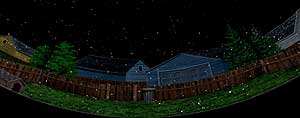
Analog stars project in the classic theater panorama
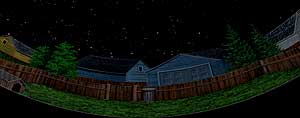
No stars in the fulldome video panorama!
In practical terms, when it comes to projecting fulldome video, it's likely that the big mechanical machine is going to be in the way. The "multiple video projectors from the pit" approach can work around this, although both systems may be competing for space at the center of the dome. So you may have to lower the analog projector into the pit so it won't cast shadows, just as you need to for your pans and all-skies today. Besides, you won't be using the analog star projector during fulldome video playback, because you'd see stars through the video, just as you do now when you see stars through slide projections.
And when it comes time to take your audiences away from Earth and fly through the galaxy, it won't be of much use. You'll be using a different visualization tool.
When the planetarium projector was first invented, space travel was just a dream; now it's a reality. Today planetarium professionals have a wide range of tools to visualize the new reality. Choose the best tool available for the job.
So if I don't use an analog star projector, where do the stars on the dome come from?
This may be one of the biggest points of confusion in fulldome systems.
When playing Loch Ness Productions shows, everything that appears on the dome is contained in our video movie file. An opto-mechanical star projector in the theater is not used during playback of these programs. Neither is the internal planetarium software that comes with many fulldome systems. All that is turned off; the video projector is dedicated to playing the movie.
When we make our shows, we use Sky-Skan's DigitalSky to generate starfields. We capture those images and incorporate them as elements in our After Effects timelines when we generate our dome masters. You'll have to ask other producers what they use for their starfields. In any event, when you're showing movies, you're not running your own star projector or its software.
But when you're not playing videos, you'll still have a fancy computer system there. You can switch out of movie player mode, and then you can run software that will display stars, planets... the entire universe, live and operated manually by your own fingers. Most fulldome systems come with some form of planetarium software. This could be proprietary software uniquely developed by the system vendor, Evans & Sutherland's Digistar. Or, the stars could be generated by special dome-enabled versions of commercial software products, such as Starry Night or TheSky. You could also run the free open-source software Stellarium to display stars (it has both fisheye and mirror warp output)... or Uniview... or create your own starfield generator program. You could have a myriad of starfields, if you want.
If you're shopping, check to see how easy the software is to learn and operate (especially in a live situation). Also important to know is how the display actually looks. You won't be going after "night sky" realism like your old star projector; this is digital computer stuff projected through video projectors, after all. But you do want your stars to have recognizable colors, you want the Milky Way to look sufficiently diffuse from an Earth-based perspective; the Sun to have a glow. You also want onscreen object labels to be subtle, adjustable, and you want to be able to navigate smoothly, without whiplash-inducing jerky moves and dome-filling shocks and jumps. You will need to comparison-shop, which could mean asking for an on-site demo from the vendor(s) you're interested in.
I am beginning to talk to the bosses here about the possibility of getting a fulldome video system. One of the big concerns is conversion of shows from the current slide and video projector technology. I am hoping I don't have to remove the slide technology at first, but can gradually convert to fulldome video.
Speaking as planetarians who have been working in the slide-based realm for more than 30 years, we're quite sure you're going to find that fulldome video will quickly become your primary medium.
You're not going to want to mess with all the slide projectors and such when you can simply hit one "Play" button and a better-looking show will play with no hassles, no dirty slides, no out-of-focus images, no worrying about whether a slide will drop in the gate — and you don't see stars through your pans and planets. It's just too "easy" — from the playback side — and all the motion and graphics more than compensate for any resolution shortcomings. You can have dozens of shows available instantly; no more running around climbing ladders to change slide trays between shows. You'll serve your clientele better, because they'll be able to choose what they want to see at your planetarium, instead of just you may happen to have installed.
In short — which was somewhat to our surprise when we started in the fulldome medium — what seemed like an over-hyped marketing slogan ("replace all your aging slide projectors") is really quite meaningful. You end up NOT wanting to use the old technology when you have the new. It does seem to become antiquated and inadequate. Our own slide projectors and automation gear were gathering dust in our studios, so we donated it all to a local high school planetarium that had no budget to pursue fulldome.
I already have a lot of your shows in slide form. The three Loch Ness Productions shows that I use most often are Season of Light, Larry Cat in Space and The Voyager Encounters. How do I make them work in fulldome?
You can of course continue to run the shows you already have on your existing slide projector equipment while it lasts. Each classic, slide-based show comes with a license agreement or a "Plain English Copyright and Usage Statement." Either way, you're allowed to use the show, as you have been, in its slide form.
In theory, if you wanted to go through all the trouble of scanning every slide (yes, even all those aging, faded mass-produced film chips), spending the hours in Photoshop cleaning them, adjusting and correcting the color, trying to reduce the inherent contrast from slide scans, creating masks, stitching together panoramas, and then making your own video, using After Effects and Virtual Projector and DomeXF, you could. We allow you to do whatever it takes to present the slide show you bought as we intend it to look in your theater.
But we can pretty much guarantee you're not going to want to do that, even if you had the resources. Why build it yourself when you can buy from the factory better, faster, cheaper instead? Take a look at the online clips we did for The Cowboy Astronomer, for example. There's so much more in our fulldome version than we provided with the slide version — sunsets and blue skies, snow, animations. Even if you were able to recreate how the slide version looks in your theater now, but using your digital projector — it wouldn't hold a candle to what we can do these days with computer graphics. So when you get your fulldome system, simply buy the fulldome show from us.
It may be worth noting that one of the prime reasons we invested the months of work on fulldome visual production for each show was for customers like you. Many have successfully run the classic shows — for two decades in some cases — but chose to (or situationally had to) retire their old finicky slide projector equipment. From the comments we hear, our fulldome products present a vast improvement to audiences, compared to what could be accomplished given the limitations of 35mm slides. We hope you will agree!
What will it cost to buy those show packages for use in fulldome video?
We thought you'd never ask. We have a summary of our show prices here, and you'll also find the prices for every show we distribute on their respective Web pages.
Is there some consideration because we already own the slide based packages?
We consider your continued support and thank you muchly for it!
While it wasn't the answer I was hoping for, I believe I understand. You are treating the fulldome video version of the shows as separate from the shows for which we already own a license.
Yes, because they really are two separate products. The video version is quite a bit more advanced onscreen than what you see with the slide show it's based on. All of our work with animation and choreography turned the collection of still images and soundtrack into a movie. The classic license is for the slide-based show package — the ingredients you have to make into a presentation. The fulldome license is for the movie — the ready-to-serve entree we've already made for you.
My bosses will not like that answer. I need to make sure they understand that the move to fulldome video will be more than just the projector system. We will have to budget several thousand in for shows or else we'll have nothing to run on the system.
Yes, the bosses will need to budget accordingly — and continually, or else you'll be running all old shows. Heck, even some of ours are getting a little long in the tooth. And they had better plan on new shows not being as inexpensive as our current offerings. We tried to keep the fulldome versions of our classic titles pretty much the same price in either form. But new shows we'll produce in the future will undoubtedly feature more 3D animation and such. This simply costs more to produce, and that will have to be reflected in the show's ultimate license fee.
Of course, you'll always have the native planetarium software on your system to run. You should always be able to give "what's up tonight" star talks. Some planetarium software systems have "scripting" capability; this allows you to record the system commands you would ordinarily enter manually, along the lines of a "macro" recorder. You can then assign those scripts you've prepared to buttons or menus, and play them back with a mouse click. Do enough of this, and you can have a "show", in a manner of speaking. But these are not shows like the fulldome movies, and if that's what your audiences are used to and expecting, well...
I know you are in business to stay in business, and your high-quality products don't come for free. You deserve to be well compensated for such fine work. I'm sorry to have to put all this to you in this manner, but we're in a school. Our planetarium has virtually no revenue; it is basically just another cost to the district. My predecessor was able to slowly build his stock of shows over many years. The financial impact was very spread out. If we do go to fulldome video, it could get very expensive very quickly.
"You got that right."
Really, the hardware is going to be more of a consideration — and its longevity — than is our showware.
If something were to fail within the projector after its warranty period has expired, it's possible it will be simply be considered obsolete, unsupported and unrepairable, like many things digital these days. It will have been replaced by a newer model, and you'll need to start over with a whole new system. That new system will undoubtedly have better resolution, which means the catalog of movies you'll have amassed won't be compatible, and you'll want to get new copies of those at higher resolution. (We already have a special pricing policy for those situations.)
You may have run into this sort of thing already with your computers and other electronics; we certainly have. Things aren't they way they were in your predecessor's day any more. We may have all thought those days would last longer than they did. It's been a new millennium for quite a while now.
I have old slide-based showkits from other vendors, too. Realistically, how much work is it going to take to reproduce these shows for fulldome video?
Realistically, more than you can imagine.
Your old shows need to made into ones and zeroes — meaning, all the visual and audio sources need to digitized into something a computer can work with. Using software tools such as those from Adobe (Photoshop, After Effects, Premiere, Audition, etc.), you'll manipulate the pictures and sound into a form suitable for your projector system's needs. Simply scanning all the slides and spending the hours cleaning them will be more than most will want to undertake. Stitching together pans, making masks...
It will take any well-trained planetarian months to produce one fulldome video planetarium show from an old show package. It takes us months to produce one of our shows, and we can put full-time attention to the task. And we have a multi-computer render farm and terabytes of disk storage space. Separate, dedicated high-end hardware is necessary for doing serious fulldome video creation. You need to be (or employ and train) an expert in Adobe products, and you need specialized tools to create and produce in dome master form. Moreover, you need to be able to spend the hours and hours and hours in front of the well-equipped graphics computer workstation. All this is beyond the resources and reach of most planetaria, especially those run by only one person.
In short, you're not likely to be re-creating old shows. The old-time planetarian's do-it-yourself school of production doesn't really work the same way when it comes to fulldome video production.
Do I have to make my shows into video? Can't I just program the images to appear on the dome through the video projector somehow?
With most systems, it's simply easier to play back movies.
But some do have a "virtual slide projector" capability. You could use the digital assets — like those we provide in our classic planetarium show packages — as source material when presenting our shows. In that case, you write and program cue files to place and size the images, play your video, fade the audio, etc. It's a process quite similar to what classic planetarium customers currently go through to program their theater's automation to control slide projectors in synchronization with the soundtrack.
However, the process for creating this type of programming on fulldome systems can be primitive, and synchronization with a soundtrack may not be easily obtainable, especially when "back-and-forthing" in a typical dome programming situation. At this stage of development, it takes anyone and everyone a long time to create programming for fulldome systems. We're talking days, weeks, and months.
Do I really need a computer to play your shows? Can't I just bring in my DVD player from home?
You may be confused by the term "video", which in this case does NOT mean "television".
Typically, a digital sized-for-TV picture on a DVD is only about 480 pixels in height. If you tried to stretch that display over an entire dome, the result will look really blurry and blocky. That's simply not a workable size for making fulldome videos.
We distribute many of our shows on data DVDs, not video DVDs. So yes, you'll need that computer system (or an equivalent storage device like a video server) hooked up to your fulldome projector.
Our planetarium currently is running 17 slide projectors (6 allsky, 5 pan, 6 main) and DVD, laserdisc, video, and a Spitz A3P starball. We have a 40-foot dome, 120 seats. I did talk to one company, and their quote for a fulldome system was nearly a half million dollars, way out of a small school district budget. I would appreciate any suggestions you can give me.
One factor that will affect your ultimate price is your dome size. At 40 feet, you're pushing the limit of what a single fulldome video projector at the center of the room is capable of illuminating. You've seen typical boardroom LCD projectors; you probably have one or several in your facility. So imagine if you were to put a fisheye lens on it to spread the display over the full dome, and project from a radius 20 feet away. You get the idea. Those few thousand pixels are going to look pretty dim and fuzzy over that distance.
The solution is, of course, money. To get more and brighter pixels up on the dome, you use more and brighter projectors. Just as with your all-sky system, when you go to a multi-projector system, there is the potential for edge-blend and alignment issues that will need attention. But you are probably dealing with many more alignment issues with your present pan and all-sky slide projectors, though.
One reality most administrators are loath to recognize: all those incandescent projectors, including the big one in the center of the room, are at the end of their practical life and usage. You got your money's worth out of them years ago, and it's probably not cost-efficient to keep nursing them along. That star machine lasted four decades, and in the '60s, it probably cost more in equivalent dollars than the digital things you can get these days. Someone felt the planetarium was important enough to have paid out all that money back then. Today, is the planetarium less important so that it can't be supported with much more capable technology that costs much less in equivalent dollars? Or, stated another way, why restrict your abilities to use only those tools that were available in the '60s? We've expanded our knowledge of the universe immensely since then, and you should have the necessary tools to show and tell people what we've learned. There's a lot more to the universe than an Earth-based view of the night sky.
And more reality: while today's digital doodads do much more, they're not going to last forty years. We're talking computer technology. Look at the computer you're using to read this. Where was it forty years ago? Do you envision using it forty years from now? Sure, the equipment you buy today will be obsolete after you sign the check. Some digital star projectors, invented 20 years after your A3P, are already obsolete. CRT video projectors are obsolete. There haven't been any new commercial slide-based show packages (produced by us or anyone else) for years; that form of presentation, once prevalent, is now passé. Film as a medium has gone away; ask Kodak, Polaroid or Nikon. If you define "planetarium" as slide projectors and star machine, you ignore evolution, and we know from history what happens when you don't evolve. We can do more, better, today, with the digital tools. Different, yes, but one does not live in the past forever.
It's that simple. Either the planetarium is important enough to support with the working tools of today, or it's a dusty relic from a past age, a museum piece. Granted, many are in museums already, so the shipping costs are low. :-)
If I get a single fisheye lens projector system, can I unscrew the lens and put in a standard one to run my PowerPoint presentations in a classroom?
Why not?
No.
For mechanical as well as optical reasons, most fisheyes require basically tearing into the video projector chassis and re-engineering the hardware to fit the lens. Nothing is simple.
Any parting words of wisdom?
Fulldome is just a technology, one of many in the planetarian's toolkit. What you do with it in the theater is what's important. People come to see the show, not the box that projects it.



